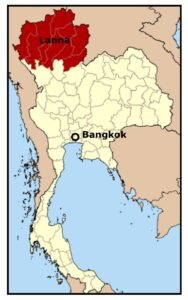World War II in Northern Thailand
(replacing Japan in Northwest Thailand during World War II)1
The subjects covered in my original website, “Japan in Northwest Thailand during World War II”, evolved to cover events involving the three major World War II entities operating in northern Thailand: Allied, Japanese, and Thai.2 Consequently, I have renamed this effort to a more realistic, “World War II in Northern Thailand” and moved to this new website, ww2norththailand.com. To ease reader access and my maintenance of the website, I am also migrating to a WordPress platform.
This website offers details which supplement the coverage that standard English language references provide on World War II activities in Northern Thailand.3
And I will continue to stray, as before, sometimes rather wide of the mark, ie, beyond the declared subject of North Thailand, and time, ie, WW2, to include details I feel are useful in understanding the war period.
 North Thailand is often referred to as Lanna and currently covers nine provinces4 located on average about 600 kilometers north of the Thai capital, Bangkok. The area shares international borders with Myanmar (Burma) to the west and north and Laos to the east.5 During the war, Thailand’s northern boundary effective expanded to include Burma’s Shan State (offsite link) and those parts of Mong Pan State (offsite link) east of the Salween River, and was called Saharat Thai Doem6 (as shown in red on map at left).
North Thailand is often referred to as Lanna and currently covers nine provinces4 located on average about 600 kilometers north of the Thai capital, Bangkok. The area shares international borders with Myanmar (Burma) to the west and north and Laos to the east.5 During the war, Thailand’s northern boundary effective expanded to include Burma’s Shan State (offsite link) and those parts of Mong Pan State (offsite link) east of the Salween River, and was called Saharat Thai Doem6 (as shown in red on map at left).
World War II in Thailand began on 08 December 1941 when Imperial Japanese Army (IJA) land forces advanced into Thailand through Aranyaprathet (Google Maps link)7 to the east of Bangkok and seaborne troops landed at seven locations along the Gulf of Thailand coast from Bang Pu just south of Bangkok to Songkhla near the border with British Malaya.8
The only reliable record dating the arrival of IJA troops in northern Thailand is from the diary of a local Chiang Mai businessman, Muangchai Chaininphan:9
15 December 1941: For Japanese troops to invade Burma, Thailand had to surrender some of its sovereignty to Japan so it could act as a passageway to Burma. Japanese soldiers were assigned to Chiang Mai as were Thai soldiers from mid-country.
16 December 1941: Soldiers tended to settle in around temples, including First Church of Christ in Chiang Mai which had closed as a result of the invasion.
They arrived by train and were greeted at the railway station by Morinosuke Tanaka, a longtime Japanese resident of Chiang Mai who was a photographer well-known and well-liked throughout the community.10
The war ended about four years later with the surrender of Japan on 15 August 1945.11 The majority of IJA troops in Northern Thailand were removed to holding camps around Bangkok by mid-December 1945 for eventual return to Japan12; however, a large concentration of IJA troops in the far west of Mae Hong Son Province in the Khun Yuam area was not discovered until January 1946 and was subsequently moved to Toungoo, Burma and presumably on south to holding camps in the Rangoon area.13
| First published on Internet | ||
| Many updates, additions, corrections by this date | ||
| Converted to WordPress by Ally Taylor | ||
| Updated, author errors & typos corrected | ||
- Header: Looking WSW at Pai Memorial Bridge; composite view of CIMG4094aa.jpg & CIMB4095aa.jpg, 26 Mar 2009, by author using Microsoft Image Composite Editor (ICE); My ref: 01313 1095 088/20090326[↩]
- in alphabetical order[↩]
- Time-tested English language references include:
E Bruce Reynolds, Thailand and Japan’s Southern Advance 1940-1945 (New York: St Martin’s Press, 1994)
Judith A Stowe, Siam becomes Thailand (Honolulu: University of Hawaii Press, 1991)
Edward M Young, Aerial Nationalism (Washington: Smithsonian Institution Press, 1995).[↩] - Wikipedia: “Regional classification of Thailand” (offsite link) [↩]
- Map: Wikipedia: “Northern Thailand“, annotated by author using Microsoft Publisher. My ref: 01000 N TH Prov1 per Wiki.jpg[↩]
- offsite link[↩]
- ประวัติศาสตร์การสงครามของไทยในสงครามมหาเอเชียบูรพา (กรมยุทธศึกษาทหาร กองบัญชาการทหารสูงสุด พ.ศ.๒๕๔๐) ๔๕ [The History of Thailand’s Armed Forces During the Great East Asia War (Bangkok: Amarin Printing and Publishing, 1997), 45][↩]
- Bang Pu, Samut Prakan; Prachuap Khiri Khan; Chumphon; Surat Thani; Nakhon Si Thammarat; Songkhla; and Pattani Provinces, ibid, pp 48-94[↩]
- “ตอนทึ่002”, “ฟ้าเชียงใหม่”, สมัยสงครามโลกครั้งที่ 2, จากสมุดจดความจำของ ม.ชัยนิลพันธ์, สงวนสิทธิ่ โดย มูลนิธิตระกูลชัยนิลพันธ์, นสพ.ไทยนิวส์, กรกฎาคม 2548 [“Episode 002”, “Chiang Mai Sky”, World War II era, From the notebook of Mr Chaininphan, All rights reserved by the Chaininphan Family Foundation, Thai News newspaper, July 2005] My ref: 03200 Chaininphan.[↩]
- Discussion with Wichit Jaravann, a retired newspaper editor, 18 Aug 2017. See also Tanaka from 1930 to 1941.[↩]
- 14 August 1945 in the US and the eastern Pacific because of time zone differences (Wikipedia, “Victory over Japan Day” (offsite link) [↩]
- S Woodburn Kirby, The War Against Japan Vol V: The Surrender of Japan (Uckfield, The Naval & Military Press Ltd, 1969), 296[↩]
- ibid, 260-261[↩]